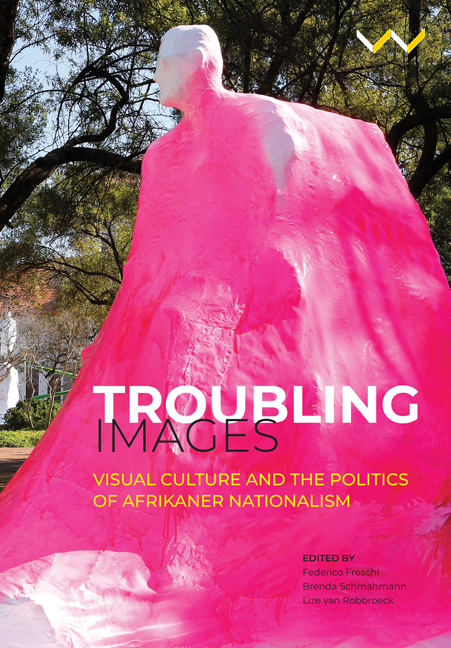Book contents
- Frontmatter
- Contents
- Acknowledgements
- List of Illustrations
- Troubling Images: An Introduction
- 1 The Trajectory and Dynamics of Afrikaner Nationalism in the Twentieth Century: An Overview
- One Assent and Dissent Through Fine Art and Architecture
- Two Sculptures on University Campuses
- Three Photography, Identity and Nationhood
- Four Deploying Mass Media and Popular Visual Culture
- Contributor Biographies
- Index
11 - Visual Narratives of the Border War in 1980s South African Print Culture
Published online by Cambridge University Press: 21 March 2020
- Frontmatter
- Contents
- Acknowledgements
- List of Illustrations
- Troubling Images: An Introduction
- 1 The Trajectory and Dynamics of Afrikaner Nationalism in the Twentieth Century: An Overview
- One Assent and Dissent Through Fine Art and Architecture
- Two Sculptures on University Campuses
- Three Photography, Identity and Nationhood
- Four Deploying Mass Media and Popular Visual Culture
- Contributor Biographies
- Index
Summary
An article appeared in the 23 June 1978 issue of the Financial Mail under the header ‘The March of Militarism’. Notwithstanding its conceptual confusion, it paints a vivid picture of the way in which militarisation had insinuated itself into all aspects of white South African lives. The piece offered the following vignettes: ‘A bakery in central Johannesburg displays in its window a birthday cake in the shape of an army tank. A few blocks away a toy shop reports that sales of “war games”, bearing names like Attack on Moscow, have jumped fivefold in the past year’ (in Magubane 2006, 82). While vendors cashed in on the market for military merchandise in the country's commercial capital, the executive capital had the appearance of being under an army of occupation. As the headquarters of the South African Defence Force (SADF), Pretoria had a conspicuous number of mustachioed men in nutria brown uniforms. In fact, permanent force members and national servicemen were highly visible in all urban centres that had large military bases. The SADF was capable of mobilising 500 000 men at short notice. It staged regular public relations exercises throughout the land to provide displays of the army's strength and war-readiness by way of military parades, air shows, tattoos, and exhibitions of captured ‘terrorist weapons’. White South Africans armed themselves to the hilt in the face of perceived threats on multiple fronts. Indeed, the country was palpably in the grip of a ‘war psychosis’ (Magubane 2006, 82–84).
The Financial Mail article was published during the last days of BJ Vorster's premiership (1966–1978). South Africa's militarisation commenced during Vorster's term but reached its apogee during PW Botha's term as prime minister (1978–1984). Militarisation is multifaceted. It operates in the political, economic, ideological, institutional, social, cultural and even personal realms. It is difficult to disaggregate these dimensions. Militarisation occurs in order to promote militarism, an ideology that legitimates state violence as a solution to conflict (Cock 1989, 10). Hence it is facilitated by a number of obvious mechanisms such as propaganda and indoctrination, as well as more subtle ones like consumerism. Consequently, it finds expression in cultural forms such as print, film, music and other media produced by the state and the private sector.
- Type
- Chapter
- Information
- Troubling ImagesVisual Culture and the Politics of Afrikaner Nationalism, pp. 273 - 298Publisher: Wits University PressPrint publication year: 2020



